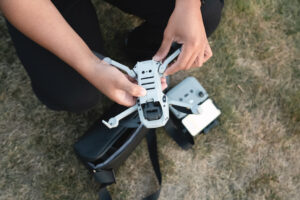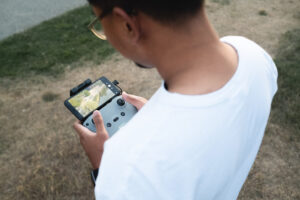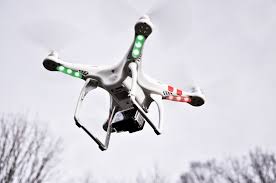To build a 115MPH+ FPV racing drone, you can follow the step-by-step guide in the YouTube video[1]. Here are the parts used in the build:
4S Version:
* Frame: http://bit.ly/2A0LO0m
* ESC/FC combo: http://bit.ly/2iDwj7L
* Motors: http://bit.ly/2AQBnMV
* VTX: http://bit.ly/2BUcLnU
* FPV camera: http://bit.ly/2AEmJcQ
* Props: http://bit.ly/2Bgpt3q
5S Version:
* Frame: http://bit.ly/2A0LO0m
* ESCs: http://bit.ly/2nGo3t4
* Motors: http://bit.ly/2nCQxUg
* FC/VTX combo: http://bit.ly/2Be1wcS
* FPV camera: http://bit.ly/2AEmJcQ
* Props: http://bit.ly/2jsRbPL
* Antenna: http://bit.ly/2A0Jqa4
For other parts, there are alternative links provided in the video description[1].
When choosing parts for a drone, consider the type of drone you want to build, such as a Toothpick, Cinewhoop, 6-inch or 7-inch, X-Class or Beast Class, or Cinelifter[2]. For beginners, a 5-inch FPV drone is recommended due to its versatility in flying style.
When selecting an ESC, consider durability and weight. Modern ESCs are often marketed with higher amp ratings for increased durability and resistance to voltage spikes. However, lower-rated ESCs may be more susceptible to damage during crashes. When sizing your ESC, consider recommendations from experienced pilots and use higher-rated ESCs if you can afford them for increased robustness and durability[3].
For firmware, consider the most important and popular ESC firmware, such as SimonK, BLHeli, and BLHeli_S[3].
Hobbywing is a registered trademark of Hobbywing technology and offers a variety of products, including brushless ESC & Motor systems, airplanes & helis, multicopters, cars & trucks, rock crawlers, boats, and more[4]. They also provide firmware updates for their ESCs[5].
Hey there, drone enthusiasts! If you’re looking to give your drone racing experience a serious boost, you’ve come to the right place. We’re about to dive into the world of Hobbywing electronics and how they can turn your FPV racer into a high-flying, record-breaking machine. Strap in, because this is where the fun begins.
Key Takeaways
Upgrading with Hobbywing can significantly enhance your drone’s speed, agility, and overall performance.
Choosing the right combination of Hobbywing motors and ESCs is crucial for compatibility and peak performance.
Safety should always be a top priority, both in terms of component choice and conducting pre-flight checks.
Installation of Hobbywing components can be straightforward if you follow a step-by-step guide.
After upgrading, tuning your drone is essential to ensure that you’re getting the most out of your new components.
Unleash Your Drone’s Potential with Hobbywing Upgrades
So, you want to crank up the performance of your FPV drone? The secret sauce is in the electronics. Just like you wouldn’t put regular gas in a sports car, you shouldn’t settle for stock parts in a racing drone. Hobbywing is the go-to for racers who want to push their drones to the limit.
Explore Hobbywing’s High-Performance Electronics
Why Hobbywing? Well, these guys are the wizards of the drone racing world. Their Electronic Speed Controllers (ESCs) and motors are top-notch, giving you that split-second advantage you need to zip past the competition. Think lightning-fast response times, bulletproof reliability, and power that just won’t quit.
Gain the Competitive Edge in Drone Racing
It’s not just about raw speed, though that’s a big part of it. Upgrading to Hobbywing means your drone will handle like it’s on rails, with precise control that responds to your every command. That’s how you pull off those jaw-dropping maneuvers that leave spectators in awe.
But before we jump into the nitty-gritty of upgrading, let’s talk about why you’d want to upgrade in the first place.

Why Upgrade Your FPV Racer?
“Upgrading your FPV racer is like giving it a shot of adrenaline – it’s all about amping up the thrill and performance of your races.”
Most stock drones come with components that are good enough for casual flying. But ‘good enough’ doesn’t cut it in the racing world. Here’s the deal: better components mean better performance. It’s that simple.
With Hobbywing’s upgrades, you’re looking at:
Increased speed and acceleration
Sharper handling and more responsive controls
Greater efficiency, which can lead to longer flight times
Enhanced durability for those inevitable crashes
Now, let’s break down what you’ll get from these upgrades.
Understanding the Benefits of High-Grade Electronics
Upgrading your drone with high-grade electronics can make a world of difference. Hobbywing’s ESCs and motors are designed to deliver maximum power with minimal weight. This means every ounce of energy from your battery is used to make your drone fly faster and more responsively.
Common Limitations of Stock Drones and Overcoming Them
Stock drones often come with limitations that can hold you back in a race. The motors might not be powerful enough, or the ESCs may not provide the quick, precise control you need. That’s where Hobbywing steps in – to help you overcome these limitations and set your drone free.
But it’s not just about slapping on some new parts. You need to choose your components wisely.
Choosing Your Hobbywing Components
When it comes to upgrading, the right fit is everything. You wouldn’t wear shoes that are too big, right? The same goes for your drone. You need to match the specs of your Hobbywing motors and ESCs to your drone to ensure they work together seamlessly.
Matching Motor and ESC Specs to Your Drone
Here’s the deal: understanding the compatibility between your drone’s motor and ESC (Electronic Speed Controller) is crucial for optimal performance. To get a deeper insight into this, you can check out our detailed article on the best FPV racing drones, where we discuss the importance of matching these components.
Check the size and KV rating of the motors. They’ve got to be right for your drone’s frame and intended use.
Make sure the ESCs can handle the current your motors will draw. Too little, and you’ll be grounded. Too much, and you’re carrying extra weight for no reason.
And remember, these components need to talk to each other like best friends. If they don’t get along, your drone’s performance will suffer.
Let’s not forget about safety, though. It’s not the most exciting topic, but it’s crucial.
Focusing on Safety First
Why bother with reliable electronics? Because the last thing you want is your drone falling out of the sky during a high-stakes race. Good quality components like Hobbywing’s reduce the risk of mid-air failures and keep your drone where it belongs – in the air.
Why Reliable Electronics Reduce Flight Failures
Think of reliable electronics as your drone’s lifeline. They’re the difference between a successful race and a crash landing. With Hobbywing, you’re investing in peace of mind, knowing that your drone has the best chance of staying airborne from start to finish.
Pre-Flight Checks and Maintenance Tips
Before every race, do your pre-flight checks. Look over every inch of your drone, make sure all connections are tight, and that your components are in tip-top shape. A little bit of maintenance goes a long way in preventing disasters.
Now, let’s get into the fun part – installing your new gear.

Installation Tips for Hobbywing Upgrades
Installing your new Hobbywing components can be a breeze if you take it step by step. You don’t need to be a tech wizard, just follow the instructions, and you’ll be fine.
Step-by-Step Guide to Swapping Components
Here’s how you do it:
Start with a clean workspace and the right tools.
Remove the old motors and ESCs, keeping track of how everything was connected.
Install the new Hobbywing motors and ESCs, double-checking every wire and solder joint.
It’s all about attention to detail. Make sure everything is secure and tidy, because a loose wire can mean the difference between winning and losing.
But what’s power without control?
Tuning for Performance
Once you’ve got your shiny new Hobbywing parts installed, it’s time to tune your drone. This is where you dial in the settings to get the most out of your upgrades. It’s a bit like tuning a guitar – get it right, and it’ll sing.
Optimizing Your Settings for New Electronics
Most importantly, take the time to adjust your flight controller settings to match your new components. A well-tuned drone is a fast drone.
Test Flying and Adjustments
After tuning, take your drone out for a spin. Start with gentle flights to see how it handles, then gradually push it harder. Pay attention to how it responds, and make adjustments as needed. It’s a process, but it’s worth it.
And there you have it – your guide to upgrading your FPV racer with Hobbywing electronics. Stick with these tips, and you’ll be tearing up the racecourse in no time. Happy flying!
Upgrading with Hobbywing can significantly enhance your drone’s speed, agility, and overall performance.
Choosing the right combination of Hobbywing motors and ESCs is crucial for compatibility and peak performance.
Safety should always be a top priority, both in terms of component choice and conducting pre-flight checks.
Installation of Hobbywing components can be straightforward if you follow a step-by-step guide.
After upgrading, tuning your drone is essential to ensure that you’re getting the most out of your new components.
Focusing on Safety First
When it comes to racing, the adage ‘safety first’ couldn’t be more applicable. The last thing you want is your drone malfunctioning at high speeds due to subpar components. That’s why investing in Hobbywing’s reliable electronics is a smart move for any serious racer. They provide the stability and dependability you need when pushing your drone to its limits.
Why Reliable Electronics Reduce Flight Failures
Quality electronics are the backbone of any high-performing racing drone. They are the difference between a smooth, responsive flight and a catastrophic failure. Hobbywing’s precision-manufactured ESCs and motors are engineered to withstand the intense demands of drone racing, significantly reducing the likelihood of in-flight failures and crashes.
Pre-Flight Checks and Maintenance Tips
Before you take to the skies, always run through a comprehensive pre-flight checklist. This should include inspecting your drone for any physical damage, ensuring all firmware is up to date, and verifying that your Hobbywing components are correctly calibrated. Proper maintenance and regular inspections can catch potential issues before they become problems in the air.
“A drone racer’s motto should be: the more thorough the pre-flight check, the smoother the race.”
Next, let’s move on to the exciting part – installing your new high-performance Hobbywing components.
Installation Tips for Hobbywing Upgrades
Upgrading your drone with Hobbywing electronics doesn’t have to be daunting. With the right tools and a bit of patience, you can transform your racer into a powerhouse. Let’s go over the key steps to ensure a successful upgrade.
Step-by-Step Guide to Swapping Components
Firstly, gather all necessary tools and components. You’ll need a soldering iron, screwdrivers, and of course, your new Hobbywing motors and ESCs. Next, carefully remove the existing parts from your drone, taking note of their orientation and wiring. Then, install your new components, making sure to follow any included instructions from Hobbywing. Securely solder all connections, as loose wires can lead to performance issues or even failure.
Ensuring Secure Connections and Optimal Layout
When installing your new components, it’s crucial to ensure all connections are secure. A loose connection can not only impact performance but also cause your drone to lose power mid-flight. Take the time to double-check every solder joint and wire. Additionally, consider the layout of your components for optimal balance and weight distribution, which can greatly affect your drone’s handling.
Tuning for Performance
With your new Hobbywing components installed, it’s time to fine-tune your drone’s settings. This is where you can really start to see the benefits of your upgrades. Proper tuning ensures that your drone performs at its best, responding quickly and accurately to your controls.
Optimizing Your Settings for New Electronics
To get started, adjust your flight controller settings to match your new Hobbywing ESCs and motors. This might involve tweaking your PID settings, throttle curves, and other parameters. It’s a trial-and-error process, but when you hit that sweet spot, you’ll feel the difference in your drone’s performance.
Test Flying and Adjustments
After tuning, it’s essential to conduct test flights in a safe, controlled environment. Start with short, low-intensity flights to observe how your drone behaves with the new upgrades. Gradually increase the intensity of your flights, making incremental adjustments to your settings as needed. With each test, you’ll refine your drone’s performance, making it faster, more agile, and more responsive.
And that’s it! By following these steps and choosing Hobbywing for your upgrades, you’re setting yourself up for success on the racecourse. Remember, the key to getting the most out of your drone is a combination of quality components, careful installation, and meticulous tuning. Now, go out there and dominate the skies!
Gaining an edge in drone racing often boils down to the finer details of your setup. That’s where Hobbywing motors and ESCs come into play. These components are engineered to provide your drone with the speed and agility necessary to outmaneuver competitors and handle the most challenging courses with ease.
Gaining Speed and Agility with Hobbywing Motors and ESCs
Upgrading to Hobbywing motors and ESCs can make a significant difference in your drone’s performance. These motors are designed for high torque and rapid acceleration, while the ESCs offer precise throttle control. Together, they enable your drone to reach higher speeds more quickly and maintain agility at those top speeds. This can be the difference between winning and losing in a race where every millisecond counts.
Testimonials from Top Drone Pilots
Don’t just take my word for it. Many top drone pilots swear by Hobbywing for their racing setups. They often cite the reliability and performance consistency as key factors in their success. One pilot mentioned, “Since switching to Hobbywing, my lap times have improved and I experience far fewer technical issues during races.”
Another seasoned racer shared, “The smooth power delivery of Hobbywing ESCs allows for more control during tight turns and complex maneuvers, which has definitely upped my racing game.”
FAQ
How do Hobbywing upgrades impact drone battery life?
Upgrading to Hobbywing components can actually improve your drone’s battery life. These high-efficiency motors and ESCs are designed to use power more effectively, which means you get more flight time out of each battery charge. However, keep in mind that higher performance often leads to more aggressive flying, which can offset some of these efficiency gains.
Are Hobbywing components suitable for beginners?
Yes, Hobbywing components are suitable for beginners who are serious about getting into drone racing. While they might be a bit more of an investment compared to basic components, they offer a level of control and performance that can help new pilots develop their skills more quickly. Plus, their durability means you’ll have more time to fly and less time repairing your drone after those inevitable crashes.
Can these upgrades improve drone stability and handling?
Definitely. The precision control offered by Hobbywing ESCs, coupled with the power of their motors, allows for finer adjustments mid-flight, which can greatly improve your drone’s stability and handling. When you’re racing, this means smoother turns and more controlled acceleration and deceleration.
What is the cost-benefit ratio of upgrading to Hobbywing?
The cost of upgrading to Hobbywing electronics is often justified by the benefits you receive. While the initial investment may be higher than some other brands, the durability, performance, and efficiency of these components can lead to fewer replacements and repairs, not to mention the potential for better race results. In the long run, many pilots find the investment to be well worth it.
Increased efficiency leading to better battery life.
Beginner-friendly due to durability and ease of control.
Improvements in stability and handling for more precise flying.
Long-term cost savings from fewer repairs and replacements.
Is technical expertise required to install Hobbywing electronics?
While installing Hobbywing electronics doesn’t require you to be a tech expert, some basic knowledge of drones and soldering skills can be helpful. Hobbywing provides detailed instructions and customer support to assist with the installation process. Additionally, there are numerous tutorials and resources available online to guide you through the upgrade. However, if you’re not confident in your ability to install the components safely, it’s always best to seek help from someone with more experience or a professional.
By now, you should have a solid understanding of how Hobbywing upgrades can transform your FPV drone into a racing powerhouse. With the right components and a little bit of tuning, you’ll be ready to compete at the highest levels. Remember, in drone racing, every advantage counts, and upgrading to Hobbywing could be the edge you need to claim victory in your next race. So gear up, get out there, and show the competition what you’re made of!
For drone enthusiasts looking to enhance their racing experience, understanding the intricacies of Hobbywing electronics can be a game-changer. These components are designed to optimize performance, offering precision control and improved power efficiency for competitive racing drones. With the right setup and tuning, pilots can achieve a significant edge over the competition.
Citations:
[1] https://www.youtube.com/watch?v=evVP9_FpNSE
[2] https://oscarliang.com/fpv-drone-guide/
[3] https://oscarliang.com/esc/



Leave a Reply